Plumbago Plant Care (Blue Plumbago and White Plumbago) – Plumbago Auriculata

Plumbago (Plumbago auriculata) is a beautiful evergreen climbing plant or shrub with clusters of blue or white flowers and glossy green spatulate leaves. The most common plumbago cultivar is the blue plumbago with pale blue, five-petaled flowers. The white plumbago (Plumbago auriculata ‘Alba’) looks similar; only it has brilliant snow-white flower heads. In colder climates, you can grow plumbago as a potted houseplant.
Depending on your climate, plumbago grows as an annual or herbaceous flowering perennial. The sprawling shrub has vining stems that can grow between 6 and 15 ft. (1.8 – 4.5 m) tall, and the shrub grows up to 8 ft. (2.4 m) wide. Plumbago is a broadleaf, evergreen shrubby bush with rounded, arching growth.
This article is a guide to growing plumbago plants to enhance your garden landscape. As well as handy care tips, you’ll find advice on growing blue plumbago in containers and how to resolve some growing issues.
How to Care for Plumbago auriculata (Cape Plumbago)
To care for plumbago plants, grow the scrambling shrub in full to partial sun. Plumbago grows best in organically rich soil that has excellent drainage. Water the plant enough to keep the ground consistently moist, especially in hot weather. Prune the fast-growing vining plumbago stems in early spring to keep the plant tidy.
Plumbago Flowers
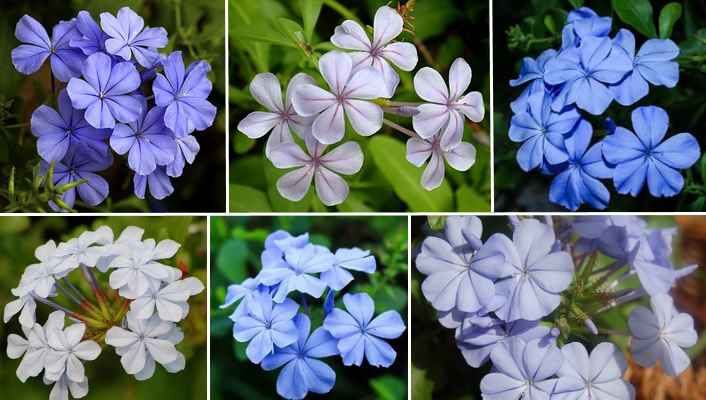
Depending on the cultivar, Plumbago auriculata flowers come in shades of blue, purple and white
The flowers on plumbago shrubs are attractive, phlox-like flowers in blue, purple or white colors with a pleasant scent. Individual flowers have five petals, and they grow in beautiful clusters. The blue and white flowers measure between 1” and 3” (2.5 – 7.5 cm).
Plumbago flowers bloom every year from spring through fall. The attractive clusters (terminal racemes) of white, soft purple and pale or darker blue flowers attract butterfly pollinators. Regular pruning can encourage prolific blooming throughout the summer to fill your garden with colorful flowers.
About Blue Plumbago (Plumbago auriculata)
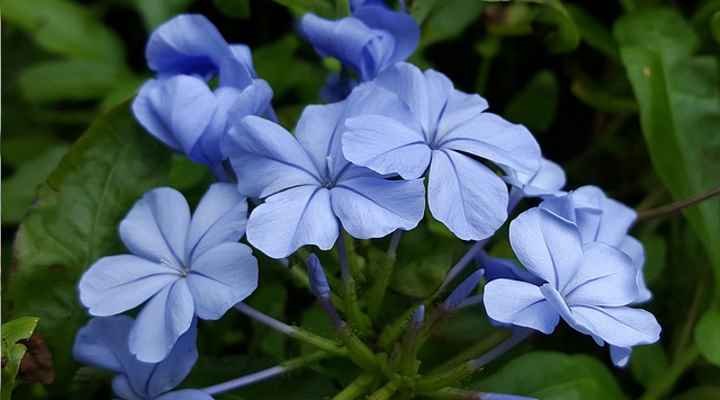
Plumbago auriculata ‘Imperial Blue’ has deep sky-blue flowers
Blue plumbago (Plumbago auriculata) is a perennial or annual evergreen shrub. Its appealing features are phlox-like lilac-blue flowers and dense green foliage. The beautiful flowers grow on the end of thin stems. Blue plumbago has simple, alternately-arranged, oblong obovate (spoon-shaped) shiny green leaves.
Blue plumbago thrives in USDA zones 9 through 11 and is easy to care for. The large, sprawling shrub has a rounded growth habit that can grow between 6 and 10 ft. (1.8 – 3 m) tall and the same width. However, sometimes the climbing vines can grow taller.
Plumbago auriculata should not be confused with dwarf plumbago or hardy plumbago (Ceratostigma plumbaginoides) which is a low ground cover perennial plant with similar flowers and leaves that grows only up to 1 ft. (30 cm) high and 1.5 ft. (45 cm) width.
The botanical name of this Plumbago species—auriculata (meaning “with ears”)—refers to the ear-like shape of the leaves. It used to have the scientific name Plumbago capensis. Other common names for Plumbago auriculata include skyflower, cape leadwort, and cape plumbago.
Imperial Blue Plumbago: The cultivar Plumbago auriculata ‘Imperial Blue’ has deep sky-blue flower clusters that bloom throughout summer until fall. The Imperial Blue plumbago grows as ground cover for full sun, flowering hedgerows, or an upright shrub. This shrubby plant also grows exceptionally well in containers.
White Plumbago (White Cape Leadwort)
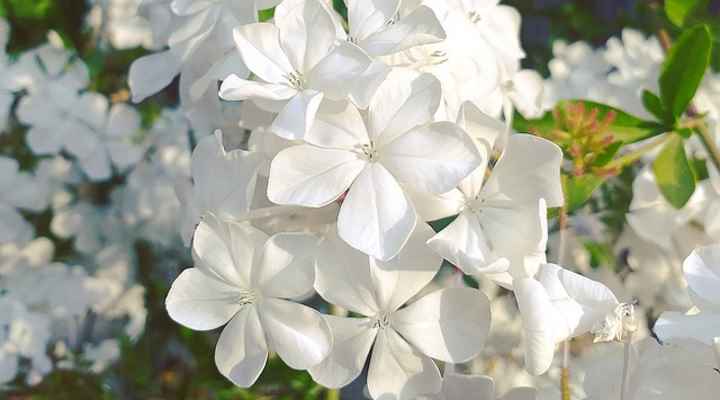
Plumbago auriculata ‘Alba’ has white flower clusters
The white plumbago (Plumbago auriculata ‘Alba’) plant has pure white flowers made up of five petals. Like the blue plumbago, the white cape plumbago has a shrub-like growth and long, thin trailing stems. In warm climates, white plumbago blooms almost all year long. In colder climates, you can grow this mounding shrub as an annual or container plant.
Like the blue plumbago, white cape plumbago thrives in zones 9 through 11. However, it may grow in warmer areas of zone 8 with some extra winter protection.
Blue Plumbago and White Plumbago Care Guide
Let’s look in more detail at how to grow blue plumbago or white plumbago in your garden landscape. You will find that it is relatively easy to grow cape plumbago or cape leadwort.
Where to Plant Blue Plumbago and White Plumbago
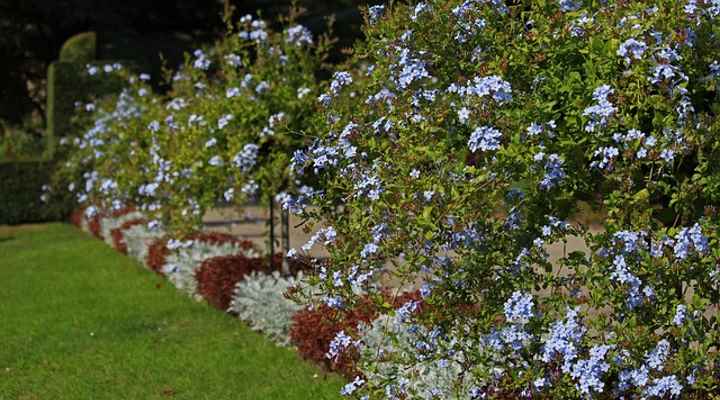
You can grow plumbago auriculata outdoors in warm regions as a border plant, informal hedgerow or as foundation plant
Plumbago plants grow as sprawling evergreen shrubs in warm regions. When deciding where to grow a plumbago plant, remember that it needs plenty of room to spread. It would be best if you planted it in the sunniest part of your front or backyard, where there is fertile, well-drained soil.
Because plumbago is a versatile shrub, there are many ways to incorporate its beautiful blue flowers and light green foliage in a landscape.
White or blue plumbago plants are ideal as foundation plants or to hide an unsightly wall or fence. The long, climbing stems with their lush green foliage and showy phlox flowers can cascade over walls, creating a white or blue waterfall effect.
By planting plumbago plants between six and 12 feet (1.8 – 3.6 m) apart, you can grow a perennial flowering informal hedgerow. Alternatively, you can plant cape plumbago as a border plant, evergreen privacy screen, or let the sprawling stems grow as fast-growing ground cover.
If you live in temperate regions, you can grow plumbago in containers and winterize them indoors from late fall until early spring.
Plumbago Light Requirements
Plumbago plants grow best in full sun or partial shade. In the hottest climates—for example, zone 11—it’s best to grow it where it gets some afternoon shade. Growing in full sun allows the trailing stems to produce plenty of blue or white flower clusters. In hot, sunny weather, you may have to water the shrubs more frequently.
Ideally, cape plumbago needs six to eight hours of sunshine daily. If the scrambling shrub gets anything less than six hours of light, you may notice that there is more foliage than flowers.
If you grow cape leadwort indoors, then place the potted plant in a bright, sunny room.
The Best Soil for Cape Plumbago
Blue or white plumbago thrives in organically rich, fertile soil that drains well. To amend the earth, you can work in peat moss and compost to boost organic matter. For drainage, add gravel or perlite to the ground. Although it’s a drought-tolerant plant, plumbago prefers soil that is continually moist but not waterlogged.
Ideally, it’s best to keep the soil reasonably loamy so that water drains well from the growing location. The addition of organic material not only adds nutrients to the ground but retains moisture and makes the soil more acidic—ideal for growing cape plumbago in the ground.
When growing blue plumbago in containers, it needs a loamy, well-draining potting mix that is amended with peat moss and perlite.
How to Water Plumbago Plants
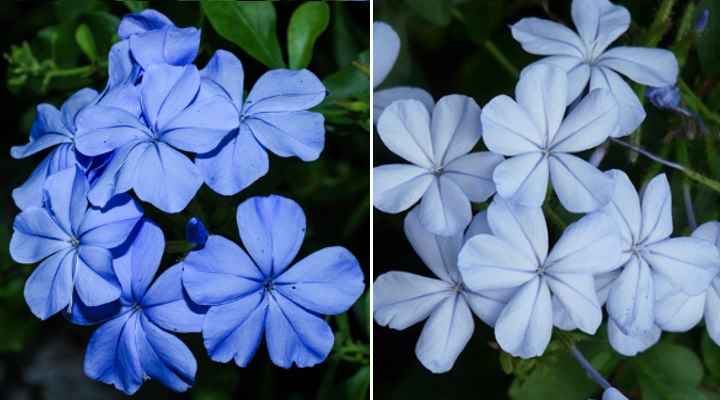
To care properly for your plumbago plant, keep the soil moist but not waterlogged
Cape plumbago needs moderate amounts of water to grow well. Once established, plumbago grows best when watered enough to keep the ground moist but not too soggy. You may have to thoroughly water the soil once a week to keep the ground moist in summer. In winter, you can water less frequently.
Plumbago is a perennial plant that tolerates drought. So, it can withstand some brief periods of dry soil as long as you drench the ground occasionally. If the plant goes dormant in winter, you can skip watering until early spring.
You will have to water a newly-planted plumbago shrub fairly frequently to help the root system develop in the ground. This may require watering twice a week or more. However, ensure that you don’t overwater the plants.
Temperature Requirements to Grow Plumbago in the Ground
Plumbago auriculata is a heat-loving perennial that thrives in USDA zones 9 through 11. You can grow plumbago in the ground all year if you have cool temperatures between 50°F and 65°F (10°C – 18°C) in the winter. In zone 8, you may have to cover the plant in winter if there’s a light frost.
Freezing temperatures or a harsh frost will kill plumbago plants. If temperatures drop below 32°F (0°C), you’ll need to winterize the plant indoors or cut it back to the ground and cover it with plenty of mulch.
Alternatively, you can grow plumbago as an annual in USDA zones 4 through 7.
Top care tip for growing plumbago: If the weather is extremely hot and dry, water the plumbago more often to keep it thriving.
Humidity for Growing Plumbago Plants in the Garden
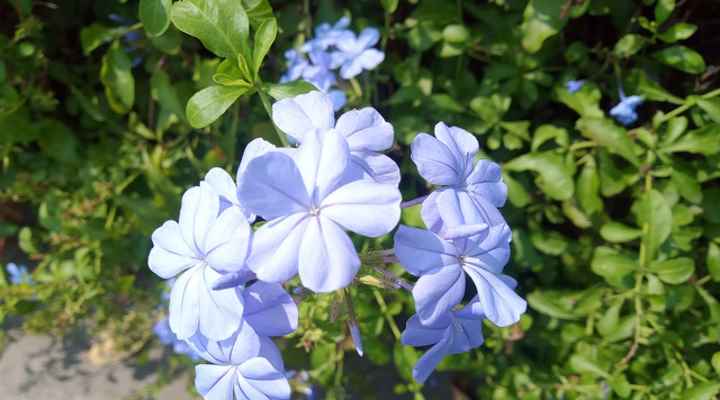
Plumbago auriculata plants love high humidity levels
Plumbago plants thrive in high humidity. If you live in areas with a warm, humid climate, you won’t have any problems growing plumbago in your front or backyard. The high air moisture levels keep the plant blooming throughout the summer and well into the fall.
Because they love humidity, cape plumbago or cape leadwort grows well in Florida, Louisiana, and California.
If you live in colder states and grow blue plumbago indoors, you’ll need to increase indoor humidity levels. Typically, household air is too dry for many tropical evergreen perennials.
How to Fertilize Plumbago auriculata
Due to its fast growth, plumbago plants benefit from monthly fertilizing during the growing season. You can use a balanced, slow-release fertilizer in early spring. Then about two months later, you can apply a diluted fertilizer every six weeks until early fall.
To encourage blooming all summer long, you could also add a teaspoon of fish emulsion to each gallon (3.7 l) of fertilizer liquid.
Top care tip for fertilizing plumbago plants: Stop fertilizing plumbago plants as soon as blooming finishes.
Pruning Blue Plumbago Plants
As part of its regular care, blue plumbago requires regular pruning to keep its shape and encourage bushy growth with plenty of flowers. The best time to prune the trailing woody stems of plumbago is in late winter or early spring. You can also do some light pruning during the growing season to keep the shrub’s shape.
To prune a blue plumbago bush, cut back stems by about one-third and cut just above a bud or lateral joint. It would be best if you also trimmed back dead branches to the base. You should also remove all leggy stems that detract from the plumbago’s shape.
If you want to encourage plenty of flowers on your plumbago plant, you should deadhead it throughout the season. Remove spent blooms to encourage new floral growth on the plant. Stop deadheading about six weeks before the first frost date.
Propagating Blue Plumbago
Taking stem cuttings in the summer is the best way to propagate blue plumbago plants. Snip a four- or five-inch (10-13 cm) woody piece of stem at a 45° angle. Dip the cut end into some rooting hormone and put it in a small pot with an appropriate potting mix. Cover with a plastic bag and place in a warm, shaded area. Mist the soil regularly to keep it moist. It should take about four weeks for roots to appear.
Once rooted, you can transfer the propagated plumbago cutting into a larger pot. When the plant is growing well, you can transfer the young plant to your garden or a larger container.
Replanting Plumbago Plants
You can transplant a plumbago plant to your garden when the soil temperature is at least 50°F (10°C). You should dig a hole in a sunny part of your garden and work in a few inches of organic compost. Place the root ball in the hole and fill in the remaining space and press down firmly. Water thoroughly to remove any air pockets and then water every few days until the plant becomes established in the landscape.
How to Grow Plumbago as a Container Plant
To grow plumbago in a pot, use a light, porous potting mix that is one-part houseplant soil, one-part peat moss, and one-part perlite. Only water the plumbago when the top 2” (5 cm) of soil is dry. Keep in a warm location in bright, indirect sunlight.
Cape plumbago is an excellent container plant, and the pot size will prevent the shrub from growing too large.
Top care tip for growing plumbago in pots: Depending on the weather, you may have to water a potted plumbago plant more often than shrubs growing in the ground.
Pests Affecting Plumbago Growth
Plumbago auriculata is resistant to most garden pests and common houseplant bugs.
Sometimes a whitefly infestation can affect the plant’s foliage. These tiny white flies cause the leaves to wither, become brown, and fall. You can eradicate pests such as whitefly on plumbago plants by hosing them off with a strong jet of water. Alternatively, you can spray a neem oil solution on all the foliage to kill whitefly.
Related reading: How to use neem oil spray on garden plants.
Diseases Affecting Plumbago Growth
Plumbago is an easy-care garden shrub that is resistant to disease. The only issues you may have with this shrub is if you overwater it or there’s poor ground drainage. Root rot can affect the plant’s growth if its roots sit in waterlogged soil.
Because plumbago is relatively resistant to drought, only water it when the soil looks dry. This way, you minimize the risk of disease.
Top plumbago care tip: When watering the plant, avoid splashing water on the leaves. This can cause the hot sun to burn the leaves. In humid conditions, excessive moisture on leaves can result in powdery mildew.
Is Plumbago auriculata Toxic?
Plumbago auriculata (cape leadwort or cape plumbago) is a toxic plant. Researchers from the University of California say that sap from the plant’s stems or leaves can cause dermatitis, painful skin rashes, or irritation.
FAQs About Plumbago Care
How do I stop plumbago from spreading?
Plumbago isn’t classed as an invasive plant. Although it spreads quickly through its rhizome roots and suckers, it is easy to prune. To stop plumbago from spreading too much, prune the plant hard in late winter or early spring.
Why is my blue plumbago dying?
Although blue plumbago is a relatively easy plant to care for, there are a few issues that can cause the foliage to wilt, turn brown, and die. The most common reason for plumbago plants to die is poor drainage. You can avoid most plant problems by not overwatering them.
Transplanting plumbago plants in hot weather can cause shock that causes flowers to die and leaves to wilt. You can revive a dying plumbago shrub by pruning dead flowers and branches and making sure it grows in moist soil.
Heavy frost can kill a plumbago plant. After the last frost in late winter or early spring, cut the stems back to the healthy growth or the ground. If the roots remain undamaged, new growth will appear in spring.
How do I winterize cape plumbago?
In USDA zones 4 through 8, you can overwinter cape plumbago plants by removing the stems, digging up the roots, and storing them in a cool, dry, dark, frost-free room.
Related articles:
